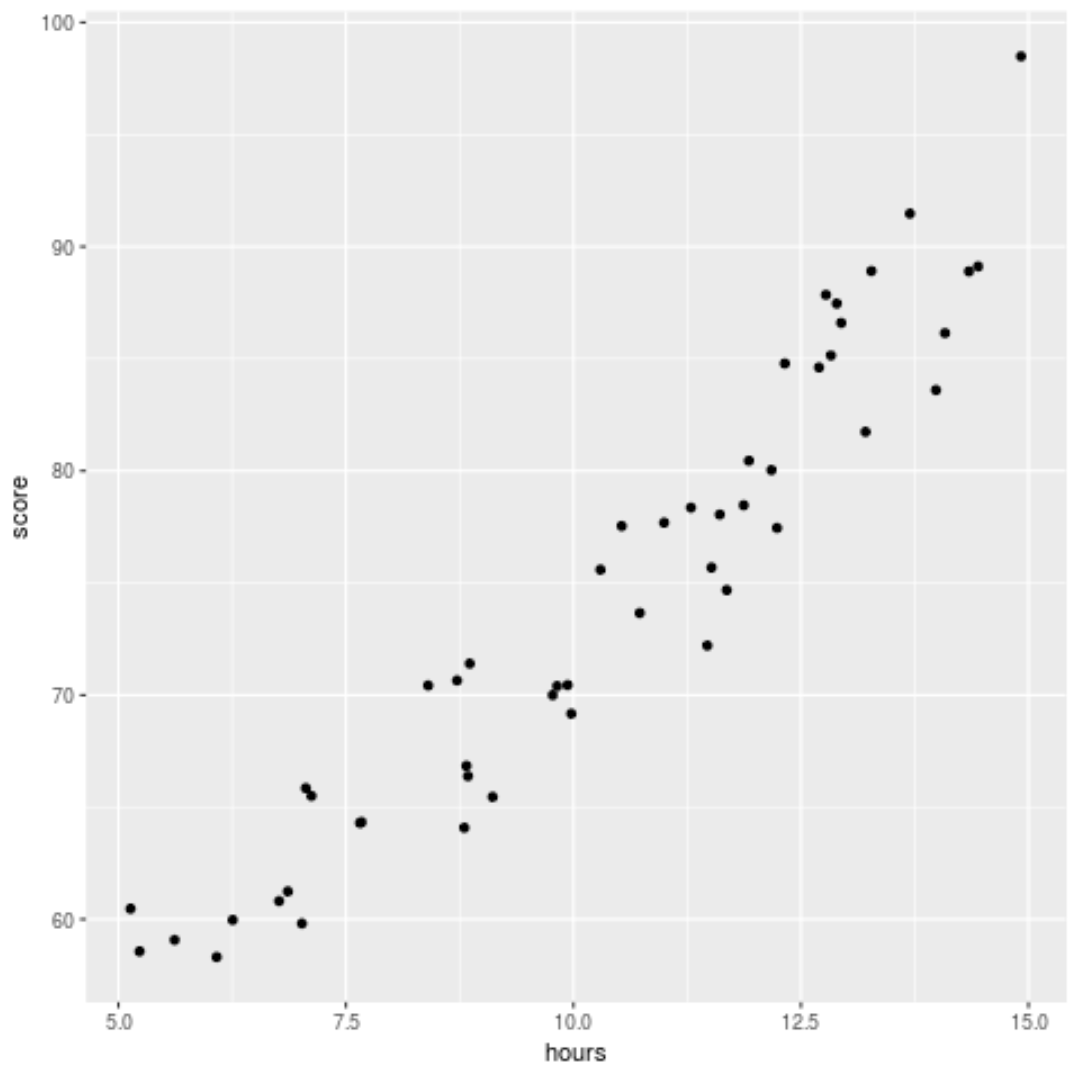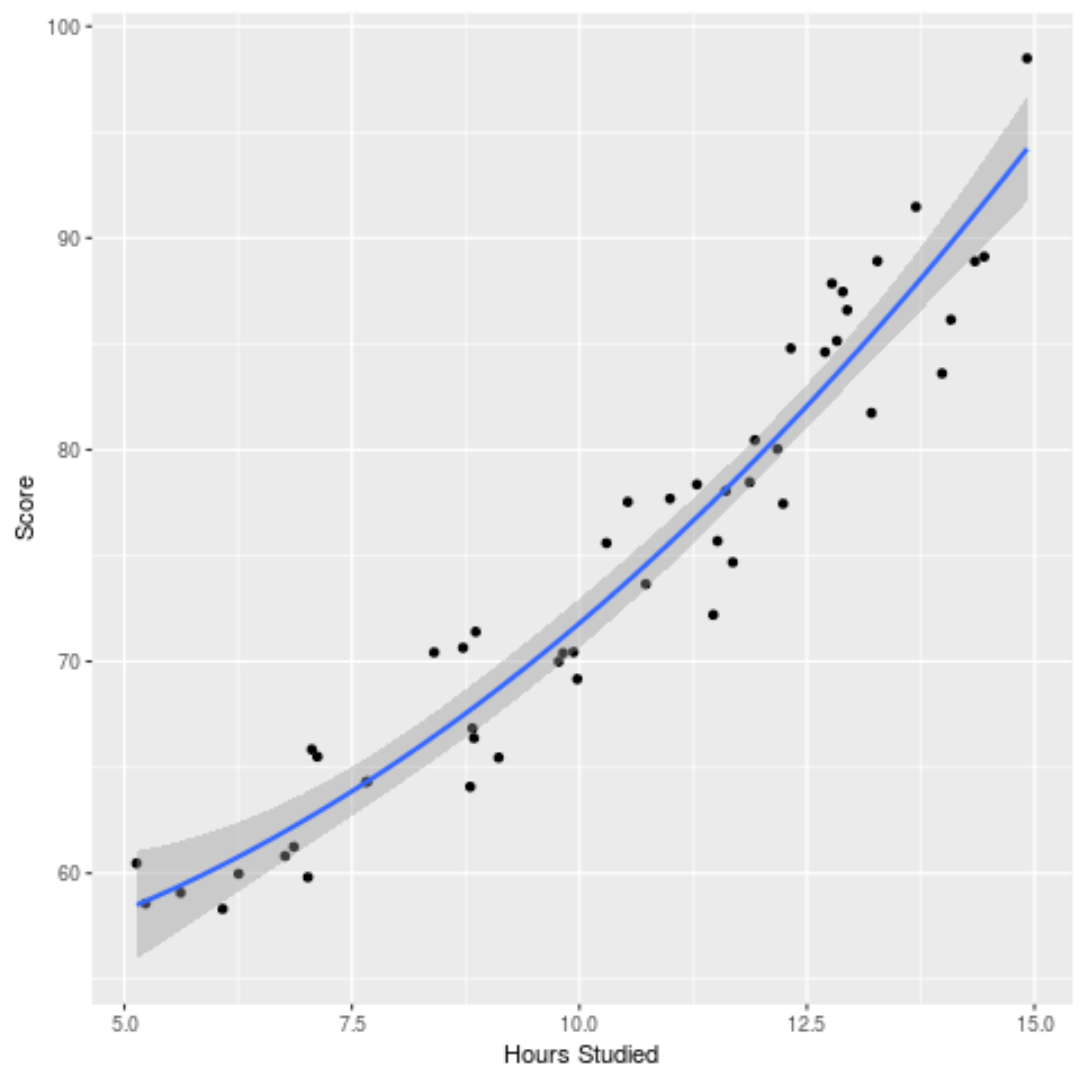R 中的多项式回归(逐步)
当预测变量和响应变量之间的关系是非线性时,可以使用多项式回归技术。
这种类型的回归采用以下形式:
Y = β 0 + β 1 X + β 2 X 2 + … + β h
其中h是多项式的“次数”。
本教程提供了如何在 R 中执行多项式回归的分步示例。
第 1 步:创建数据
在此示例中,我们将创建一个数据集,其中包含 50 名学生的班级的学习小时数和期末考试成绩:
#make this example reproducible set.seed(1) #create dataset df <- data.frame(hours = runif (50, 5, 15), score=50) df$score = df$score + df$hours^3/150 + df$hours* runif (50, 1, 2) #view first six rows of data head(data) hours score 1 7.655087 64.30191 2 8.721239 70.65430 3 10.728534 73.66114 4 14.082078 86.14630 5 7.016819 59.81595 6 13.983897 83.60510
第 2 步:可视化数据
在将回归模型拟合到数据之前,我们首先创建一个散点图来可视化学习时间和考试成绩之间的关系:
library (ggplot2) ggplot(df, aes (x=hours, y=score)) + geom_point()

我们可以看到数据具有轻微的二次关系,表明多项式回归可能比简单线性回归更好地拟合数据。
步骤 3:拟合多项式回归模型
接下来,我们将拟合五个不同的多项式回归模型,其次数h = 1…5,并使用 k = 10 次的 k 倍交叉验证来计算每个模型的 MSE 检验:
#randomly shuffle data
df.shuffled <- df[ sample ( nrow (df)),]
#define number of folds to use for k-fold cross-validation
K <- 10
#define degree of polynomials to fit
degree <- 5
#create k equal-sized folds
folds <- cut( seq (1, nrow (df.shuffled)), breaks=K, labels= FALSE )
#create object to hold MSE's of models
mse = matrix(data=NA,nrow=K,ncol=degree)
#Perform K-fold cross validation
for (i in 1:K){
#define training and testing data
testIndexes <- which (folds==i,arr.ind= TRUE )
testData <- df.shuffled[testIndexes, ]
trainData <- df.shuffled[-testIndexes, ]
#use k-fold cv to evaluate models
for (j in 1:degree){
fit.train = lm (score ~ poly (hours,d), data=trainData)
fit.test = predict (fit.train, newdata=testData)
mse[i,j] = mean ((fit.test-testData$score)^2)
}
}
#find MSE for each degree
colMeans(mse)
[1] 9.802397 8.748666 9.601865 10.592569 13.545547
从结果中我们可以看到每个模型的MSE测试:
- h 度 = 1 的 MSE 检验: 9.80
- h 度 = 2 的 MSE 检验: 8.75
- h 度 = 3 的 MSE 检验: 9.60
- h 度 = 4 的 MSE 检验: 10.59
- h 度 = 5 的 MSE 检验: 13.55
测试 MSE 最低的模型是次数h = 2 的多项式回归模型。
这符合我们对原始散点图的直觉:二次回归模型最适合数据。
第四步:分析最终模型
最后,我们可以获得表现最好的模型的系数:
#fit best model best = lm (score ~ poly (hours,2, raw= T ), data=df) #view summary of best model summary(best) Call: lm(formula = score ~ poly(hours, 2, raw = T), data = df) Residuals: Min 1Q Median 3Q Max -5.6589 -2.0770 -0.4599 2.5923 4.5122 Coefficients: Estimate Std. Error t value Pr(>|t|) (Intercept) 54.00526 5.52855 9.768 6.78e-13 *** poly(hours, 2, raw = T)1 -0.07904 1.15413 -0.068 0.94569 poly(hours, 2, raw = T)2 0.18596 0.05724 3.249 0.00214 ** --- Significant. codes: 0 '***' 0.001 '**' 0.01 '*' 0.05 '.' 0.1 ' ' 1
从结果中我们可以看出,最终的拟合模型为:
分数 = 54.00526 – 0.07904*(小时)+ 0.18596*(小时) 2
我们可以使用这个方程来估计学生根据学习小时数将获得的分数。
例如,学习 10 小时的学生应该得到71.81的成绩:
分数 = 54.00526 – 0.07904*(10) + 0.18596*(10) 2 = 71.81
我们还可以绘制拟合模型来查看它与原始数据的拟合程度:
ggplot(df, aes (x=hours, y=score)) + geom_point() + stat_smooth(method=' lm ', formula = y ~ poly (x,2), size = 1) + xlab(' Hours Studied ') + ylab(' Score ')

您可以在此处找到本示例中使用的完整 R 代码。